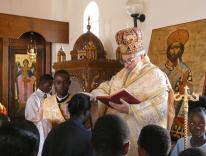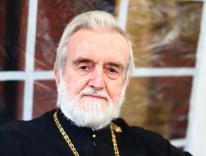The title of Gerald W. Schlabach’s new book, Unlearning Protestantism, makes it sound more provocative than it really is. In a time when it’s become common for Christians to switch from one church or denomination to another, Schlabach urges stability, understood as a dogged loyalty that “keeps us together even when we’re pissed off at each other.” He considers stability part of “the genius of the Catholic tradition.” It is, he thinks, a quality that Catholics take for granted and Protestants need to learn. He mentions more than once Dorothy Day’s famous judgment, with its echo of St. Peter’s question: “As to the church, where else shall we go, except to the Bride of Christ, one flesh with Christ? Though she is a harlot at times, she is our Mother.”
Schlabach has gradually come to agree with that judgment. As a young Mennonite, he went to Notre Dame to study theology and became a Benedictine Oblate in 1997. Later he cofounded a grassroots movement of Mennonites and Catholics called Bridgefolk. Finally, in 2004 he entered into full communion with the Catholic Church, though his wife, Joetta, remains a Mennonite (see his Commonweal article “You Converted to What?” June 1, 2007). He says he became a Catholic because it is now as possible “to be a Mennonite Catholic as it is to be a Franciscan or a Benedictine or a Salesian Catholic.”
Unlearning Protestantism is a sustained argument that the “Protestant principle” itself needs tradition. Protest and dissent are meaningless apart from communion, and stability is what holds loyalty and protest together. “Protestantism tends to undo itself,” Schlabach writes in his opening chapter, “The Protestant Dilemma.” The individualistic impulse set in motion by reformers tends in time to corrode their ecclesial commitments. As Stanley Hauerwas has written, Protestantism legitimated a “form of social life that undermined its ability to maintain the kind of disciplined communities necessary to sustain the church’s social witness.” Schlabach credits Hauerwas with having intuited the “Protestant dilemma” decades ago, and Hauerwas’s influence on the younger theologian is unmistakable. If we see Hauerwas as “trying to unlearn Protestant vices that may at another time have been Protestant virtues,” Schlabach writes, the seeming inconsistencies of Hauerwas’s “high-church Mennonite” ecclesial posture “all snap into coherence.” Protestantism worked in the first place because the reformers’ “habits and communal practices” had been formed within the longer and larger tradition. For Hauerwas, Christian ethics must always begin with the church, which is where Christian virtue is formed, and stability and fidelity are what hold church communities together over time.
In chapter 2, Schlabach considers the Protestant dilemma in its Mennonite form. At the heart of this chapter is theologian John Howard Yoder, whom Schlabach offers as an example of his general observation that “dissenters almost always owe more to tradition than they know.” Despite Schlabach’s obvious admiration for Yoder, he concludes that Yoder failed to realize the extent to which his critiques of U.S. nationalism and his own Mennonite community depended on what Yoder, in a different context, dismissed as “mere ethnicity and stifling traditionalism.” The title of this chapter, “The Matter of Continuity,” captures the difference between Yoder and Hauerwas. Yoder located continuity in the intellect of those who kept the church’s memory rather than in the “organic habits of social practice” so important to Hauerwas. Schlabach thinks Hauerwas saw something about the Mennonite tradition that Yoder himself could not see: that it was, significantly, a tradition of dissent.
The next three chapters of Unlearning Protestantism offer an extended treatment of stability, beginning with its role in the Benedictine Rule, which has proved over time its capacity to engender “a tradition in which flexibility, adaptation, critique, and reform are possible within the nurture of deep continuities.” Emphasizing that the Benedictine Rule’s obedience is to Christ, Schlabach applies the principle of stability to Christian life beyond the cloister. “My wife,” he writes, “is my abbess.”
Stability is also a touchstone of Schlabach’s ecclesiology. He proposes “a stable narrative of Vatican II”—one that understands aggiornamento as a “Catholic way to apply the Protestant principle at its best.” And he refuses to pit ressourcement against aggiornamento; they are, for him, two sides of the same evangelical purpose, the one helping us to restore lost parts of the Christian tradition, the other allowing us to plant the tradition in new soil.
Chapter 5 deals with “loyal dissent,” which for Schlabach means practicing “stability in hard times.” For some Catholics, “dissent” contradicts “orthodoxy.” Others know it as their own chronic condition. But neither liberal nor conservative Catholics can assume that Schlabach, with his roots in a Free Church tradition, means what they do by the word “dissent.” He argues that no form of communal life can rule out the need for principled disagreement, protest, or critique—even critique of legitimate authority. But he also insists that moments of disagreement and protest make no sense apart from communion. Hence the need for loyalty, even in exile.
Schlabach never quite offers a technical definition of “loyal dissent.” Instead, he describes examples of it, in stories about Yves Congar, Dorothy Day, Dom Hélder Câmara, Oscar Romero, and Joan Chittister. In his final chapter, he argues that global civil society requires the same virtues that sustain Christian community. He ends by filling out the idea of tradition that is implicit throughout the rest of the book.
My chief reservation about Unlearning Protestantism has to do with Schlabach’s strategy of deferring substantive ecclesiological questions. His claim that he is not writing to convince Protestants to become Catholic works as long as he focuses on formal questions about the practices and virtues needed to sustain communal life, rather than on substantive questions of ecclesiology that divide Christians. But this approach also leads Schlabach to mystify stability—to treat it as a principle that Catholics just happen to possess and value rather than as a central characteristic of the church as Catholics understand it.
This strategic suspension of the ecclesiological is intended to help Christians from various traditions learn from one another in spite of their serious disagreements. But the deferred questions—especially the question of continuity—can’t be put off forever. Does each generation of Christians begin from scratch? Or is the church a trace of God’s work in Christ that extends over time and place? Does it only flash into existence with inspired holiness or does its offer of grace abide in spite of its sins? If the church does not abide, then Dorothy Day’s answer to the question “Where shall we go?” is illusory.
I work every day with Protestant students and colleagues who are “yearning for some new kind of catholicity,” and Schlabach’s inspiring stories of “loyal dissent” rang true to me. A book like this, addressed both to Protestant and Catholic readers, is bound to have its critics. Some may take issue with Schlabach’s treatments of Yoder and Hauerwas. Vatican II scholars may fault him for not engaging more extensively with the literature on the council. Others may lament his use of the contested word “dissent.” With each new revelation of clergy sexual abuse we have a fresh manifestation of the failure of the church’s highest authorities to respond in a consistently truthful and pastoral manner. Is Schlabach’s picture of a post–Vatican II “participatory hierarchy” too rosy? Or is his exhortation to stability all the more timely? Either way, Schlabach’s Mennonite Catholic perspective highlights a distinguishing characteristic of the Catholic Church that many Catholics are too close to notice.
Please email comments to [email protected] and join the conversation on our Facebook page.
Previous Story
Roll Call Fourth Grade
Next Story
Alternate Ending

